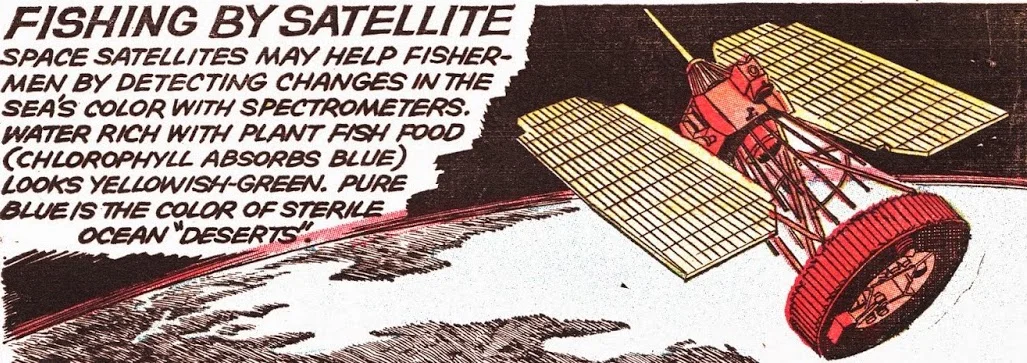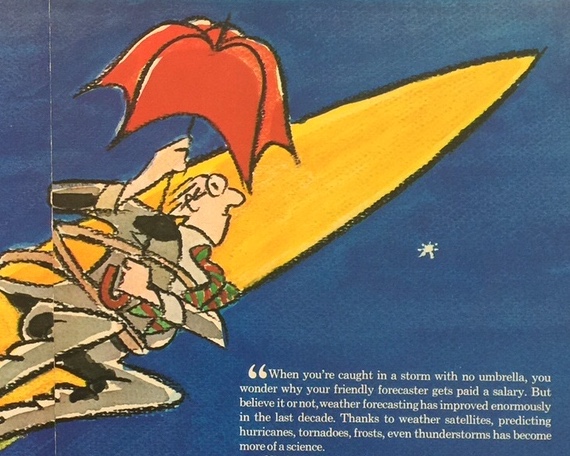Our New Age, 1957-1973
"Unearthly Influences on Weather," Our New Age. Text by Athelstan Spilhaus, drawn by Gene Fawcette. First published February 26, 1967. Image from the collection of Ger Apeldoorn, posted at The Fabulous Fifties.
Last week the American Geophysical Union recognized one of my historian heroes. Erik Conway won the 2017 Athelstan Spilhaus Award, for enhancing the public’s engagement with Earth and space sciences. Erik and his colleague Naomi Oreskes have helped to transform our understanding of the public “debates” about climate change science, acid rain, secondhand tobacco smoke, and the ozone hole. In Merchants of Doubt, they documented how a handful of prominent anti-communist scientists repeatedly spread confusion and promoted ignorance, to undermine political action that would curb the freedom of major corporations to sell dangerous products. Erik's other books have synthesized the history of NASA’s atmospheric science programs, traced the development of blind landing systems for airplanes, and analyzed the techno-politics of supersonic flight. He’s the house historian at the Jet Propulsion Lab, as well as an avid skier and model rocketeer.
Erik’s award got me thinking about Athelstan Spilhaus again. Spilhaus (“Spilly” to his friends) had an astonishing career. Between 1958 and 1973, he wrote an educational comic strip that was syndicated in more than 100 newspapers. Before, during and after that time, he was a meteorologist, instrument inventor, academic dean and science policy entrepreneur. After studying with Carl-Gustav Rossby during the 1930s, Spilhaus invented the bathythermograph, a key tool for studying the temperature structure of the ocean (and for finding where submarines can hide from sonar). He taught the weather cadet generation at NYU early in World War II, then volunteered for active service, parachuting behind enemy lines to establish a covert weather reporting network. Postwar he consulted with the Air Force on a program using mylar balloons to catch radioactive debris from Soviet nuclear tests. When an experimental balloon crashed in 1947, the unfamiliar material and Air Force secrecy combined to create Roswell, New Mexico’s new identity. (And my favorite Spilhaus headline: “Athelstan Frederick Spilhaus, inventor of aliens, died March 30th, aged 86.”) He moved to the University of Minnesota as Dean of the institute of Technology, where he conceived the idea for the National Sea Grant Program. For more than 50 years, this program has supported oceanographic research, public engagement with science, and greater knowledge about the role of the oceans and Great Lakes in the lives of Americans. (Regular readers won’t be surprised to learn the Trump Administration wants to kill off Sea Grants, just like Regional Climate Centers and the Air Resources Laboratory.) But Spilly’s widest outreach effort came from his comic strip, Our New Age.
"Space Weather Forecast," Our New Age. Text by Athelstan Spilhaus, drawn by Gene Fawcette. Dated 10/28, year unknown. Published online at ComicArtFans.com by Hart Rieckhof.
Like so much else in 20th century American science, Our New Age was a response to Sputnik. Over 15 years, Spilhaus worked with three different artists to make scientific knowledge fun and accessible. Each Sunday comic strip illustrated a recent advance in science or engineering, discussing its implications for how people might live, work or play in the future. When Spilhaus and John F. Kennedy met in 1962, the president apparently told him, “The only science I ever learned was from your comic strip.”
"Population" Our New Age. Text by Athelstan Spilhaus, drawn by Gene Fawcette. First published June 19, 1960. Image from the collection of Ger Apeldoorn, posted at The Fabulous Fifties.
Spilhaus was quite confident that science was an influence for good, but he took a realistic view of its limitations. His June 19, 1960 strip about global population growth is a good example. After noting the medical science has helped add 22 years to the life of the average American since 1900, he did a little math to show the impossibility that space colonization could relieve population pressure on Earth. The other strips reproduced here, on space weather, satellite based ocean observation, and cosmic influences on the atmosphere, reflect Spilhaus’ characteristic style: attentive to known scientific facts, alive with their implications for daily life.
"Fishing by Satellite," Our New Age. Text by Athelstan Spilhaus, drawn by Gene Fawcette. First published July 23, 1967. Image from the collection of Ger Apeldoorn, posted at The Fabulous Fifties.
Learn More:
- Sharon Moen, With Tomorrow in Mind: How Athelstan Spilhaus Turned America to the Future (University of Minnesota Sea Grant College Program, 2015).
- Dan Kraker, “How a far-sighted Minnesota scientist pointed America toward the future,” Minnesota Public Radio News, October 14, 2016.
- Matt Novak, “Sunday Funnies Blast Off into the Space Age,” Smithsonian Magazine, January 27, 2012.
- Holcomb Noble, “Athelstan Spilhaus, 86, Dies; Inventor With Eye on Future,” New York Times, April 1, 1998.








